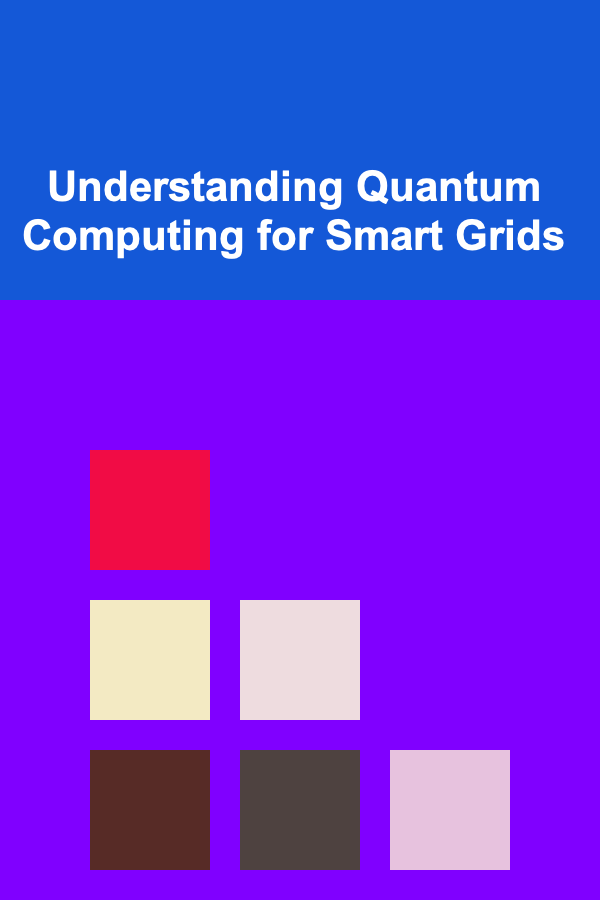
Understanding Quantum Computing for Smart Grids
ebook include PDF & Audio bundle (Micro Guide)
$12.99$11.99
Limited Time Offer! Order within the next:

Introduction: The Convergence of Two Revolutionary Fields
The modern power grid is undergoing a radical transformation, evolving from a centralized, unidirectional system to a decentralized, bidirectional, and intelligent network -- the "smart grid." This evolution is driven by the increasing adoption of renewable energy sources, the proliferation of smart devices, and the growing demand for greater efficiency and reliability. However, the complexities inherent in managing such a vast and interconnected system present significant computational challenges.
Enter quantum computing, a paradigm shift in computation that leverages the principles of quantum mechanics to solve problems intractable for even the most powerful classical computers. While still in its nascent stages, quantum computing holds immense potential to revolutionize various fields, and the smart grid is no exception. This article aims to provide a comprehensive understanding of how quantum computing can be applied to address the key challenges and unlock new possibilities within the smart grid ecosystem. We will delve into the fundamental concepts of quantum computing, explore its potential applications in grid optimization, security, and forecasting, and discuss the current limitations and future prospects of this exciting technology.
Quantum Computing: A Primer
To appreciate the potential impact of quantum computing on the smart grid, it's crucial to understand its underlying principles. Unlike classical computers that store information as bits representing either 0 or 1, quantum computers utilize qubits . Qubits leverage two key quantum mechanical phenomena: superposition and entanglement.
Superposition
Superposition allows a qubit to exist in a probabilistic combination of both 0 and 1 simultaneously. Think of it like a coin spinning in the air -- it's neither heads nor tails until it lands. Mathematically, the state of a qubit can be represented as: |ψ⟩ = α|0⟩ + β|1⟩, where α and β are complex numbers representing the probability amplitudes for the qubit being in the state |0⟩ and |1⟩, respectively, and |α|² + |β|² = 1. This ability to explore multiple possibilities concurrently gives quantum computers an exponential advantage in certain types of calculations.
Entanglement
Entanglement is a bizarre but powerful phenomenon where two or more qubits become linked together in such a way that they share the same fate, no matter how far apart they are. If you measure the state of one entangled qubit, you instantly know the state of the other, regardless of the distance separating them. This interconnectedness allows quantum computers to perform highly correlated computations and explore complex relationships between variables more efficiently.
Quantum Algorithms
The true power of quantum computing lies in the development of specialized quantum algorithms that exploit these quantum phenomena to solve specific problems. Two prominent examples are:
- Shor's Algorithm: This algorithm is designed to factor large numbers exponentially faster than any known classical algorithm. This has significant implications for cryptography, as many widely used encryption schemes rely on the difficulty of factoring large numbers.
- Grover's Algorithm: This algorithm provides a quadratic speedup for searching unstructured databases. While not as dramatic as Shor's algorithm, it still offers a substantial advantage for certain types of search and optimization problems.
Other relevant quantum algorithms include Variational Quantum Eigensolver (VQE) and Quantum Approximate Optimization Algorithm (QAOA) which are used for optimization problems and are particularly relevant to smart grid applications.
Quantum Hardware
Building and maintaining quantum computers is an incredibly challenging task. Qubits are extremely sensitive to their environment, and even the slightest disturbance can cause them to lose their quantum properties -- a phenomenon known as decoherence. Several different physical platforms are being explored for building qubits, including:
- Superconducting circuits: This is currently the most mature and widely used approach, employed by companies like Google and IBM.
- Trapped ions: This approach uses individual ions trapped in electromagnetic fields as qubits. It offers high fidelity but is more difficult to scale.
- Photonic qubits: This approach uses photons (particles of light) as qubits. It offers good coherence and potential for long-distance quantum communication.
- Neutral atoms: This approach uses neutral atoms trapped in optical lattices as qubits. It offers good scalability and coherence.
Each of these platforms has its own advantages and disadvantages, and the "best" approach is still an open question.
Quantum Computing Applications in Smart Grids
The complex and dynamic nature of the smart grid presents a multitude of challenges that quantum computing may be uniquely suited to address. These challenges range from optimizing energy distribution and resource allocation to enhancing cybersecurity and improving forecasting accuracy.
1. Optimization of Energy Distribution and Resource Allocation
The smart grid involves managing a complex network of power generation, transmission, and distribution. Optimizing this network to minimize energy losses, reduce costs, and ensure reliability is a computationally intensive task. Quantum algorithms can potentially offer significant improvements in this area.
Problem: Optimal Power Flow (OPF)
OPF aims to determine the most efficient way to dispatch power from various generation sources to meet demand across the grid, while satisfying various constraints such as voltage limits, transmission line capacities, and generator operating limits. This is a highly non-linear and non-convex optimization problem that can be extremely difficult to solve for large-scale grids.
Quantum Solution: QAOA and VQE
Quantum Approximate Optimization Algorithm (QAOA) and Variational Quantum Eigensolver (VQE) are two quantum algorithms that show promise for solving OPF problems. These algorithms work by mapping the OPF problem onto a quantum system and then iteratively optimizing the system to find the best solution. While still in the early stages of development, simulations have shown that these algorithms can potentially outperform classical algorithms for certain types of OPF problems, especially those with high levels of complexity and uncertainty. Specifically:
- QAOA (Quantum Approximate Optimization Algorithm): It's a hybrid quantum-classical algorithm, meaning it relies on both quantum hardware and classical processors. It's designed to find approximate solutions to combinatorial optimization problems. In the context of smart grids, it can be used to optimize the scheduling of power generation resources, minimize energy losses, and improve grid stability. QAOA can handle problems like unit commitment (determining which power plants should be online) and economic dispatch (optimizing the output of online power plants).
- VQE (Variational Quantum Eigensolver): Primarily used for finding the ground state energy of a quantum system, VQE has applications in simulating molecule behavior (useful for developing better batteries) and, more relevantly, in solving optimization problems related to power flow. It iteratively refines a solution by varying parameters until the lowest energy state, representing the optimal or near-optimal solution, is found.
Example: Imagine a smart grid with numerous renewable energy sources, electric vehicle charging stations, and distributed energy storage systems. Determining the optimal scheduling and dispatch of these resources in real-time, while considering fluctuating energy prices and demand patterns, is a formidable optimization problem. Quantum algorithms could potentially find solutions that minimize costs, reduce congestion, and improve the overall efficiency of the grid.
2. Enhanced Cybersecurity
The smart grid is becoming increasingly reliant on digital technologies, making it vulnerable to cyberattacks. Protecting the grid from these threats is crucial to ensure its reliability and security. Quantum computing can play a significant role in both enhancing cybersecurity and posing new challenges.
Problem: Vulnerability to Classical Cryptographic Attacks
Many of the cryptographic algorithms currently used to secure the smart grid, such as RSA and ECC, are based on the difficulty of factoring large numbers or solving the discrete logarithm problem. These algorithms are vulnerable to attacks from quantum computers running Shor's algorithm, which can factor large numbers exponentially faster than any known classical algorithm.
Quantum Solution: Quantum Key Distribution (QKD) and Post-Quantum Cryptography
Quantum Key Distribution (QKD) offers a fundamentally different approach to cryptography that is based on the laws of physics, rather than mathematical assumptions. QKD allows two parties to securely exchange a secret key that can be used to encrypt and decrypt messages. Any attempt to eavesdrop on the key exchange will inevitably disturb the quantum state of the qubits, alerting the legitimate parties to the presence of an eavesdropper.
- Quantum Key Distribution (QKD): This allows secure key exchange between two parties, leveraging the principles of quantum mechanics. Any attempt to eavesdrop on the key exchange process will inevitably disturb the quantum state, alerting the legitimate parties. This is extremely valuable in securing communication channels within the smart grid, preventing malicious actors from intercepting or manipulating data.
While QKD provides excellent security, it is currently limited by distance and infrastructure requirements. Therefore, Post-Quantum Cryptography (PQC) is also being actively developed. PQC involves developing classical cryptographic algorithms that are resistant to attacks from both classical and quantum computers. The National Institute of Standards and Technology (NIST) is currently in the process of selecting a set of PQC algorithms to be standardized for use in the future.
Example: Protecting critical infrastructure assets, such as substations and control centers, from cyberattacks is paramount. QKD could be used to secure the communication channels between these assets, preventing hackers from gaining unauthorized access and disrupting grid operations. Alternatively, PQC algorithms could be used to encrypt sensitive data stored on grid control systems.
3. Improved Forecasting Accuracy
Accurate forecasting of energy demand and renewable energy generation is essential for efficient grid management. Quantum machine learning algorithms have the potential to improve forecasting accuracy by identifying complex patterns and relationships in the data.
Problem: Uncertainty and Variability in Renewable Energy Sources
Renewable energy sources, such as solar and wind, are inherently variable and unpredictable. This variability can make it difficult to forecast energy generation accurately, which can lead to imbalances between supply and demand and potentially destabilize the grid.
Quantum Solution: Quantum Machine Learning (QML)
Quantum machine learning (QML) leverages the principles of quantum mechanics to accelerate and improve machine learning algorithms. QML algorithms can potentially process large datasets more efficiently than classical machine learning algorithms and identify subtle patterns that would be missed by classical methods. This could lead to more accurate forecasts of energy demand and renewable energy generation, enabling better grid management and reducing the need for costly backup generation.
- Quantum Machine Learning (QML): Quantum algorithms can enhance various machine learning tasks, such as pattern recognition, classification, and regression. In the smart grid, QML can improve the accuracy of forecasting renewable energy generation, predicting electricity demand, and detecting anomalies in grid operations. This results in better resource allocation, reduced energy waste, and improved grid stability.
Example: Consider a smart grid with a large amount of solar power generation. Accurately forecasting the amount of solar power that will be generated on a given day is crucial for ensuring that the grid can meet demand. QML algorithms could be trained on historical weather data and solar power generation data to predict future solar power output with greater accuracy, allowing grid operators to make more informed decisions about resource allocation.
4. Enhanced Grid Resilience
Smart grids are increasingly vulnerable to extreme weather events and other disruptions. Quantum computing can help to improve grid resilience by enabling faster and more efficient response to these events.
Problem: Rapidly Reconfiguring the Grid After a Fault
When a fault occurs in the grid, such as a downed power line, it is crucial to rapidly reconfigure the grid to isolate the fault and restore power to affected areas. This is a complex optimization problem that requires finding the best way to reroute power flows while satisfying various constraints.
Quantum Solution: Quantum-Accelerated Optimization for Fault Management
Quantum computers can be used to accelerate the process of finding the optimal grid reconfiguration after a fault. Quantum algorithms can explore a larger number of possible solutions more quickly than classical algorithms, enabling grid operators to respond more rapidly and effectively to disruptions. This can minimize the impact of faults and improve the overall resilience of the grid.
Example: After a major storm, a large portion of the grid may be without power. Quantum computers can be used to quickly determine the optimal way to reroute power flows and restore service to the greatest number of customers in the shortest amount of time. This can significantly reduce the duration of outages and improve the overall resilience of the grid.
5. Smart Meter Data Analysis
Smart meters generate vast amounts of data that can be used to understand energy consumption patterns, detect anomalies, and improve grid efficiency. However, analyzing this data can be computationally intensive. Quantum machine learning can speed up this process and extract more valuable insights.
Problem: Analyzing Massive Datasets from Smart Meters
The sheer volume of data generated by smart meters can be overwhelming. Classical algorithms can struggle to process this data efficiently and extract meaningful insights. Identifying patterns in energy consumption, detecting fraud, and predicting equipment failures are all challenging tasks that require advanced data analysis techniques.
Quantum Solution: Quantum Machine Learning for Smart Meter Data Analysis
Quantum machine learning algorithms can process smart meter data much faster than classical algorithms, allowing grid operators to gain insights in real-time. This can lead to more efficient energy management, improved grid reliability, and reduced costs. For example, quantum algorithms can be used to identify consumers who are using more energy than expected, detect anomalies that may indicate equipment failures, and predict future energy demand with greater accuracy.
Example: Anomaly detection in smart meter data can help identify theft of electricity, faulty meters or even identify potential malicious activities trying to destabilize the grid. Quantum ML can rapidly analyze and identify these outliers.
Challenges and Limitations
Despite its immense potential, quantum computing is still a relatively young technology and faces significant challenges that need to be addressed before it can be widely deployed in the smart grid.
- Hardware Limitations: Quantum computers are still prone to errors and have limited qubit counts. Building stable and scalable quantum computers with high fidelity is a major engineering challenge. Decoherence remains a significant hurdle, as qubits are extremely sensitive to environmental noise.
- Algorithm Development: Developing quantum algorithms that can outperform classical algorithms for specific smart grid applications requires significant research and development. Many existing quantum algorithms are still theoretical and have not been thoroughly tested on real-world problems.
- Software and Programming: Programming quantum computers requires specialized skills and tools. The development of user-friendly quantum programming languages and development environments is essential for making quantum computing accessible to a wider range of users.
- Cost: Quantum computers are currently very expensive to build and maintain. The cost of quantum computing hardware and software needs to be significantly reduced before it can be widely adopted in the smart grid.
- Integration with Existing Infrastructure: Integrating quantum computing systems with existing grid infrastructure will be a complex and challenging task. This will require the development of new interfaces, protocols, and data formats.
- Quantum Supremacy vs. Quantum Advantage: While quantum computers may achieve "quantum supremacy" (demonstrating the ability to perform a calculation that is impossible for classical computers), achieving "quantum advantage" (demonstrating a practical benefit over classical computers for a real-world problem) is a more significant milestone. Focusing on achieving quantum advantage for specific smart grid challenges is crucial.
Future Prospects and Research Directions
Despite the challenges, the future of quantum computing in the smart grid is bright. Ongoing research and development efforts are focused on addressing the limitations and unlocking the full potential of this technology. Some key research directions include:
- Developing more robust and scalable quantum hardware: Researchers are working on improving the stability, fidelity, and qubit count of quantum computers. This includes exploring new qubit technologies and developing error correction techniques.
- Developing new quantum algorithms for smart grid applications: Researchers are actively developing new quantum algorithms that can solve specific smart grid problems more efficiently than classical algorithms. This includes algorithms for optimization, forecasting, cybersecurity, and data analysis.
- Developing quantum software and programming tools: Researchers are working on developing user-friendly quantum programming languages and development environments that make it easier to program quantum computers.
- Exploring hybrid quantum-classical approaches: Combining quantum and classical computing resources can be a promising approach for solving complex smart grid problems. Hybrid algorithms can leverage the strengths of both quantum and classical computers.
- Developing quantum-safe cryptography: Researchers are actively developing post-quantum cryptographic algorithms that are resistant to attacks from both classical and quantum computers.
- Conducting pilot projects and demonstrations: Conducting pilot projects and demonstrations of quantum computing in the smart grid is essential for validating the technology and identifying potential applications.
- Focusing on Near-Term Quantum Applications: Instead of waiting for fault-tolerant, large-scale quantum computers, focusing on applications that can be tackled with Noisy Intermediate-Scale Quantum (NISQ) devices will be more realistic in the short-term. These applications may involve hybrid quantum-classical algorithms and focus on specific sub-problems within the smart grid.
Conclusion: A Quantum Leap for the Smart Grid
Quantum computing holds the promise of revolutionizing the smart grid by enabling more efficient energy distribution, enhancing cybersecurity, improving forecasting accuracy, and enhancing grid resilience. While significant challenges remain, ongoing research and development efforts are paving the way for the widespread adoption of quantum computing in the smart grid. As quantum computers become more powerful and accessible, they will undoubtedly play an increasingly important role in shaping the future of the energy industry and ensuring a more sustainable and reliable power grid for all. The integration of these two transformative technologies offers a unique opportunity to address the growing complexities of the modern power system and unlock new possibilities for a more efficient, resilient, and secure energy future. By understanding the fundamentals of quantum computing and its potential applications, we can better prepare for the quantum revolution and harness its power to create a smarter and more sustainable grid.

How to Create a Family Command Center at Home
Read More
How to Decorate Your Home for the Holidays with Natural Elements
Read More
How to Use Labels for a Tidy Kitchen Drawer System
Read More
The Manufacturing Engineer's Toolkit: Proven Methods for Streamlining Production
Read More
How to Start Speed Skating (Long Track and Short Track)
Read More
How to Identify and Avoid Processed Foods
Read MoreOther Products

How to Create a Family Command Center at Home
Read More
How to Decorate Your Home for the Holidays with Natural Elements
Read More
How to Use Labels for a Tidy Kitchen Drawer System
Read More
The Manufacturing Engineer's Toolkit: Proven Methods for Streamlining Production
Read More
How to Start Speed Skating (Long Track and Short Track)
Read More